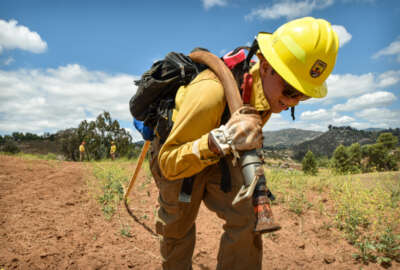

Fighting increasingly dangerous wildfires falls on federal, state and local government agencies — each with their own fire mitigation projects and data.
Fighting increasingly dangerous wildfires falls on federal, state and local government agencies — each with their own fire mitigation projects and data.
But the Federal Chief Data Officers Council is developing ways to use this interagency data to reduce the spread and severity of wildfires. That includes removing some trees, shrubs and grasses before they have a chance to burn.
Roshelle Pederson, the chief data officer for Wildland Fire, said reducing fuel sources can help reduce the severity of wildfires.
“When we think about fire behavior, we talk about it as a triangle. So there are three sides of the equation: One is weather, one is topography, and one is fuels. We really can’t influence weather or topography, so the only side of the equation that we can make have any impact on is that fuel side,” Pederson said.
There are at least five federal wildland fire management agencies — the Forest Service, Bureau of Land Management, National Park Service, Fish and Wildlife Service and Bureau of Indian Affairs.
Those five agencies work with 59 states and territories and 3,000 local and county agencies, as well as 374 tribal agencies. A wider network of federal agencies, including the Defense Department and the U.S. Geological Survey, also contributes to wildfire mitigation efforts.
“Wildland fire doesn’t care about agency boundaries, it doesn’t recognize land ownership. It just moves across the landscape, and so we to have a way to be able to coordinate our response activities and our planning activities for mitigation projects,” Pederson said on a recent episode of All About Data.
The CDO Council last year launched the Fuels Knowledge Graph Project (FKGP), which uses knowledge graphs to achieve more interoperability between agencies’ data.
“We could work with CalFire and say, ‘OK, what does this concept mean to you,’ and then what does that concept mean to BLM? And we could draw the relationship between that,” Pederson said. “It means that we don’t have to take everybody and force them into the same round hole. They can have their different-sized pegs and we can just describe that and understand the relationships between them, without making everybody use the same database or even put all of their data in the same location.”
The Federal Data Strategy’s 2021 action plan specifically directs the Interior and Agriculture departments to share data with other federal and state land management agencies to respond more effectively to wildfires.
“There are about 40 principles outlined in the Federal Data Strategy, and I would say this pilot probably hit on 30 of them,” Pederson said. “We were mindful of the components of the Federal Data Strategy and designed this pilot to support that approach and to be able to address those specific components.”
California saw its worst year for wildfires on record in 2020. In response, the Forest Service worked with the state to create a shared stewardship agreement. Part of that agreement emphasized increasing vegetation treatments to reduce the risk of wildfires. But Pederson said that partnership underscored the need for agencies to be able to share resources.
“What we’ve seen is that when you work in this multi-jurisdictional environment, each agency has their own culture, their own way of thinking about their program, about talking about it, their own terminology, sometimes we use the same term to mean different things, or we use different terms to represent the same concept,” Pederson said. “What we looked at doing was seeing if we could use data to help bridge some of those inconsistencies, and to facilitate sharing of planned activities, and how we would measure the effectiveness of those activities.”
Copyright © 2025 Federal News Network. All rights reserved. This website is not intended for users located within the European Economic Area.
Jory Heckman is a reporter at Federal News Network covering U.S. Postal Service, IRS, big data and technology issues.
Follow @jheckmanWFED



